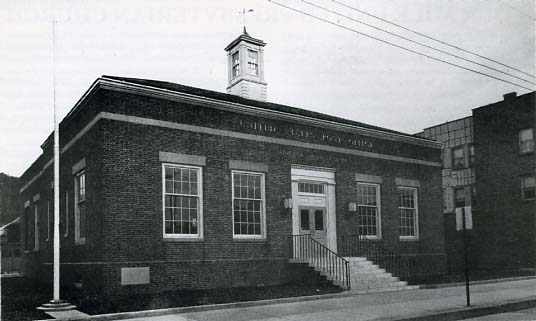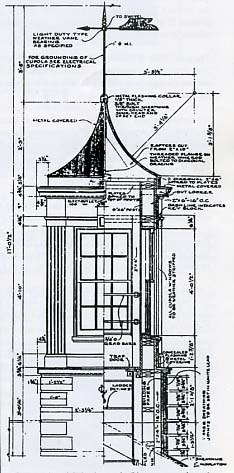
Click Here to Return to Milestones

More than ninety post offices are credited with providing service to county residents over the years. Many of the names disappeared around the turn of the century. Twentieth Century History of Beaver County, page 350.
In today's fast-paced day and age, most people take the U.S. mail service pretty much for granted, even though part of every individual and business's daily ritual is to "check the mail". We receive letters and a variety of material, sometimes from all over the world, and it is postmarked usually just a few days earlier.
It wasn't always that way.
In 1785 Andrew Ellicott, the surveyor, sent a letter to his wife in Baltimore. He was camped on the state line in South Beaver Township, opposite Darlington, PA. "This letter will reach you in about 20 days. It must go by way of Philadelphia..." he wrote. The time it took is not the most amazing thing - the fact that she received it at all is something to ponder. Fortunately, this was not a portend of things to come.
The earliest mentioned post offices in Beaver County was some 15 years later at Frankfort Springs. In 1802, the Beaver and Georgetown offices were opened. At Georgetown, Pa., Thomas Foster was issued a postmaster's commission bearing the date April 1, 1802. The steady rise of the postal system in Beaver County and the country as a whole was inevitable.
Offices were set up by postmasters in comers of hotel lobbies, general stores and private homes. As rural populations shifted so did the post offices.' With the boom of the industrial revolution, towns began to grow exponentially.
With the subsequent industrial bust (the Depression), the federal government found it prudent to somehow invigorate the country's economy. Among the many programs and projects it instigated, one was the building of federal post offices in selected towns.
The post office in Midland, Pa., which in 1989 celebrated its 50th anniversary, was built under this program. In the county, the Beaver Falls post office was built in this way also, at about the same time.

As fortune would have it, the specification sheets for the Midland office were made available recently and proved to be quite enlightening. The "spec sheets" are actually an 8" x 121/2" manual of 170 pages - small print. The blueprints and 16 8" x 10" black and white glossy prints of various stages of construction were also found.
On page one of the manual, prior to the index was the Notice to Printer - Government Form of Invitation for Proposals.
Procurement Division. Public Buildings Branch. Washington. D.C., June 30, 1938. Sealed proposals in duplicate will be publicly opened in this office at I p.m., Aug. 3, 1938, for construction of the U.S.P.O., at Midland, Pa. Upon application, one set of drawings and specifications will be supplied free to each general contractor interested in submitting a proposal...
W.E. Reynolds, Assistant Director of Procurement, Public Building Branch.
The index pages list 38 sections, which are printed here. We show them as a guide to the scope of the requirements made upon the contractor. Most are fundamental building procedures that are still used today. There are a few materials that have been ruled out completely now - mainly because of health and safety findings. And a couple of the recognizable dated sections are listed. But changes have been made.
Section I General Conditions
Addendum A
2 Applicable Minimum Hour Rates of Wages
3 General Requirements
4 Samples
5 Excavation, Filling, Grading, Etc.
6 Seeding
7 Concrete and Cement Work
Mortars
8 Sub-Drainage System
9 Waterproofing - Dampproofing
10 Brick Work, Structural Tile Work, Etc.
11 Exterior Stone Work
12 Structural Metal Work
13 Miscellaneous and Ornamental Metal Work
Brass - Bronze
Metal Counter Covering
Vault Doors
14 Steel Windows
15 Hollow Steel Windows
16 Hollow Metal Work
17 Metal Plumbing Enclosures
18 Sheet Metal Work
19 Composition Roofing
Insulation
20 Shingle Roofing
Slate
21 Lathing, Plastering, Furring
22 Interior Marble Work
23 Interior Architectural Terra Cotta
24 Tile Work
25 Terrazzo Work
26 Resilient Flooring
Cork Carpet
27 Wood Work
Carpentry
Millwork
Fixtures
28 Insect Screens
29 Metal Weather Strips
30 Builders' Hardware
31 Painting and Finishing
32 Applied Floor Finishes
33 Glass and Glazing
34 Mechanical Equipment
35 Plumbing
36 Heating Apparatus
37 Conduit and Wiring System
38 Lighting Fixtures
SECTION I contains a one-page addendum preceding the General Conditions. There are six and one-half pages (extra fine print) of General Conditions.
SECTION 2 Applicable minimum hourly rates of wages. This section is probably the most revealing when comparing 1938 and the present. Some 37 occupations and their minimum hourly rates are listed. A few of them are:
OCCUPATIONS MIN. HOURLY RATE
Asbestos Workers $1.00
Bricklayers 1.50
Cement Finishers 1.00
Electricians 1.37-1/2
Electricians' Tenders .80
Laborers, Unskilled .70
The top paying job listed is under the Operators -
Shovels, 3/4 yard or less 1.56-1/2
SECTION 3 General requirements, page 2 photographs.
Paragraph 8. Progress photographs shall be furnished in triplicatc on the first of each month until the work is 99 per cent completed, taken from two points selected by the construction engineer showing as much as possible of the work installed during the previous month. Photographs shall be 8 by 10 inches in size and mounted on muslin.
Note: In paragraph 7, instructions are to mark on the back of each picture the name of the work, the contractor and the date taken. Picking a photo at random the back reads..."U.S. Post Office, Midland, Pa. Win. F. McCarthy, Contr., Dec. 31, 1938." Then typed ... "View taken from N.E. comer and shows condition of work on above date." (Signed) Shelby Post Const. Engr. Then hand stamped: "Mr. ...(Lilzau)... Please examine these photographs and return them to the desk at once, with any comments you may have to make regarding discrepancies in the work as shown thereby; your initials to be placed thereon before returning. W.G. NOLL. Supt. of Architecture (initialed) CRD 1-16-39." Then another hand stamp: "PROGRESS PHOTOGRAPHS ROUTED AND CHECKED AS FOLLOWS: MR. BARTON (checked off) MR. BROOKS (checked off)." Finally, the stamp of Arthur J. Nichols, Midland, Pa., well-known local professional photographer. The instructions at this point appear to have been followed implicitly.
SECTION 6 Seeding - General
1. All lawn and grass plots shall be seeded, unless otherwise specified.
2. Seeding shall be done with either mixture No. I or mixture No. 2 as specified herein. (It goes on to give the formulas for ten mixtures of seeds. This takes a whole page.)
No. I is 17 parts Kentucky blue grass, 4 parts red top, 3 parts Italian rye grass and one part white clover.
No. 2 is 4 parts Kentucky blue grass, I part red top, and 1/4 part white clover.
SECTION 10 Brick work, structural tile work, etc.
Paragraph 5. Face brick shall withstand a wick test for seven days in distilled water without showing signs of efflorescence or staining. In making the wick test, the brick shall be brushed clean and placed on end in distilled water about 1-inch deep and allowed to stand at room temperature for seven days. The appearance of efflorescence or staining during or at the end of the test shall be sufficient cause for rejection.
SECTION 31 Painting and finishing - general.
Materials shall be high grade products of well-known manufacturers and when approved shall be delivered on the work in original unbroken packages bearing the makers' names and brands. Materials not otherwise specified shall conform to the Federal Specifications for same, viz: Linseed oil, raw; Linseed oil, boiled; White lead, paste, type B; Turpentine, type 1; Zinc oxide, french process; Drier, type A; Putty, white lead-whiting; Varnish; Shellac Varnish, type 2 bleached, light body; Varnish, interior; Oil base paint.
SECTION 36 Heating apparatus
Paragraph 4. Boiler shall have a manufacturer's published rating of not less than 2,200 square feet of direct cast-iron steam radiation. The rating is to be based on burning an average grade of bituminous run-of-mine coal containing 14,000 B.T.U. per pound and 8 percent ash. The rating above noted must be in accordance with the Steel Heating Boiler Institute code.
The $75,000 building - a sizable sum then - was finished and dedicated in the early surnmer of 1939 by the usual local, state and federal officials. Kate Haydon, who had been the postmaster since 1934 at the old location (in a building now owned by the Knights of Columbus) was the first to use the spacious new postmaster's office. She served until Feb. 1954. Harry (Bud) Humbert served for approximately one year and was replaced by Angelo Cellini who was appointed O.I.C. April 20,1955. When Cellini died in December 1985, Jim Dominawski was appointed O.I.C.
Robert "Bob" Kadilak, who had been appointed a carrier in 1944, and had actually served as a part-time carrier while still in high school, was appointed postmaster on July 19,1986. Kadilak had served as assistant postmaster from 1965 until appointed as superintendent. Kadilak is the present postmaster.
There have been many improvements to the classic structure, but they are not visible as changes. It still retains the charm of its original design.

